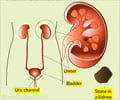Hyperglycemia (increased blood glucose) can lower sodium level in blood. In such cases, use Medindia's
Corrected Sodium Calculator to calculate the sodium level in patients to overcome the deficit.
Sodium is an essential nutrient and is needed by the body in relatively small amounts(unless substantial sweating occurs). It helps to maintain the balance of bodily fluids and ensures muscles and nerves function smoothly.
Abnormalities in serum sodium concentration, such as hypernatremia (high sodium level) and hyponatremia (low sodium level), are common electrolyte disorders (
1✔).
Serum sodium concentration is regulated by water homeostasis, which is mediated by thirst, arginine vasopressin, and the kidneys.
Recommended sodium intake
Adults (≥14 years): 1,500–2,300 mg/day, as per the IOM and WHO guidelines.
Children (2-14years): 1200- 2,300 mg/day, adjusted based on calorie intake, based on WHO guidelines (
2✔).
People with hyperglycemia: 1,500 mg/day (
3✔)
Hyponatremia (sodium deficiency)
Hyponatremia is a medical condition caused due to the low sodium level in blood usually below 135 mEq/L (mmol/L). Sodium helps maintain
blood pressure and proper functioning of body tissues like nerves and muscles. Some of the causes of hyponatremia include diarrhea,
kidney disease, sweating and vomiting. Patients with mild hyponatremia (129 and 134 mEq/L or mmol/L) may experience symptoms like weakness, dizziness, headache and nausea. Hyponatremia can be severe if the sodium level falls below 129 mEq/L or mmol/L causing
seizures,
coma and even death.
Hyponatremia is diagnosed by three tests- serum osmolality, urine osmolality, and urinary sodium concentration test (
4✔).
Hyponatremia Due to Hyperglycemia
Hyponatremia can be a consequence of hyperglycemia and it frequently appear in diabetic patients. The condition also poses a threat to health because it results to osmotic movements of water from cells in the body into the bloodstream thereby diluting sodium levels a condition known as pseudohyponatremia (
5✔).
When a patient has hyponatremia, the serum osmolality should be tested – if this is high, the hyponatremia is most likely caused by high glucose levels (hyperglycemia).
Sodium Correction Calculator will help to accurately assess true sodium levels in patients with hyperglycemia.
Corrected Sodium Calculation Formula:
Medindia's Corrected Sodium Calculator uses the authorized and widely accepted Sodium Correction equation to provide accurate sodium level corrections for patients with hyperglycemia. This ensures reliable results that align with standard medical guidelines for sodium imbalance management.
Corrected [Na]= Actual [Na] + 1.6 × [Glu]− 5.6mmolL (or 100mgdL ) / 5.6 (or 100) (
6✔)
Dietary Recommendations of Sodium
For patients managing both Hyponatremia Due to Hyperglycemia, a diet should include:
- Low-Sodium Options: Reduced sodium intake by 30% to manage hyperglycemia.
- Protein Sources
- Focus on whole grains and high-fiber foods to stabilize blood sugar (7✔).
For individuals with hyponatremia, the diet should emphasize:
- Increased Sodium Intake: Add more salt to meals (unless contraindicated by kidney disease).
- Maintain proper hydration while monitoring fluid intake to prevent dilutional hyponatremia (8✔).
FAQs
1. What is the sodium correction calculator for glucose?
The sodium glucose calculator is a formula used to adjust serum sodium levels based on elevated glucose levels, helping to determine true sodium status in patients with hyperglycemia.
2. Why is sodium correction important in patients with hyperglycemia?
Sodium correction is essential because hyperglycemia can cause pseudohyponatremia, leading to misinterpretation of sodium levels and potentially inappropriate treatment.
3. What glucose level should be used in the sodium correction formula?
Use the patient's serum glucose level in mg/dL. The formula adjusts sodium based on glucose levels above 100 mg/dL.
4. What is pseudohyponatremia?
Pseudohyponatremia is a condition where the serum sodium level appears low due to high glucose levels, not due to actual sodium deficiency.
5. How often should corrected sodium be monitored in hyperglycemic patients?
Corrected sodium should be monitored regularly, especially during treatment for hyperglycemia or if there are significant changes in glucose levels.
6. What are the risks of not correcting sodium levels properly?
Failure to correct sodium levels can lead to complications like osmotic demyelination syndrome, overcorrection, or inadequate treatment of hyponatremia.
7. When should I consult a healthcare professional regarding sodium levels?
Consult a healthcare professional if you experience symptoms of hyponatremia (e.g., headache, confusion, seizures) or if there are significant fluctuations in blood glucose levels.
8. Is 134 sodium level dangerous?
A sodium level of 134 mmol/L is slightly below the normal range, which typically falls between 135-145 mmol/L. This condition is known as mild hyponatremia. While 134 is not immediately dangerous, it may indicate an underlying issue, especially if the sodium level continues to drop or symptoms develop.
Recommended Readings on Sodium
Hyponatremia is an electrolyte imbalance causing low blood sodium levels. It is a dangerous condition that causes fluid retention in the brain leading to coma or even death. The causes, symptoms and treatment of hyponatremia are described below.
With increasing health awareness, a lot of people are making sure that they eat nutritious food. A well-balanced diet is not only important for growing children, it is equally important for the middle-aged group as well as the elderly. But are your ...
Interactive section of Medindia explains Colics due to a moving Kidney stone
Interactive section of Medindia gives general information about Male Urinary System.
Dialysis is an artificial process for removing excess water and waste from the blood. Hemodialysis and peritoneal dialysis are the types of dialysis.
Stones in the urinary system can form in the kidneys and can sometimes travel down towards the bladder to give rise to acute colics.
Everyone requires good nutrition, be it man, woman, child or elderly. However, nutrition that men need differs slightly from that required by women. Find out how ...
Minerals are important for our body and are helpful to keep the vital organs functioning. Hence we should know the right amounts of the important minerals to be included in our daily diet.
Have you stopped socializing because of a leaky bladder ?Here are some tips that will put you back on the party trail!
Cut back on salt, restrict your fluid intake and limit consumption of proteins if you suffer from kidney failure.
Heart Disease and Cancer are the major killers for men above the age of 40. Cholesterol lowering through diet, lifestyle, and medications should be considered as the "real male multivitamin".
Medindia presents you a calculator for measuring the corrected creatinine clearance, based on your height and weight.
Do you have a problem with urinary leakage? Don't suffer in silence seek help but first find out the severity of the leak by using this calculator.
Dialysis Efficiency Calculator or Kt/V calculator is an interactive tool that indicates how well dialysis is working for you and checks if enough water and waste products are cleared from your blood.













